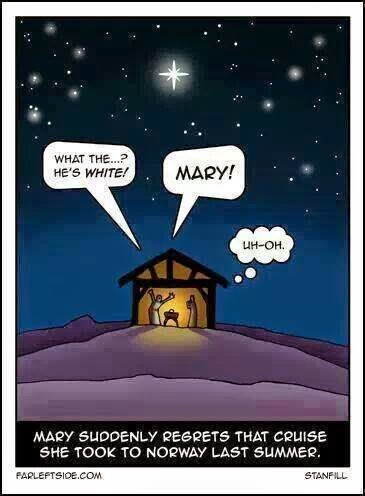“Unto You Is Born … a Saviour”
Luke 2; Matthew 2
LDS manual: here
Purpose
To show continuity problems and historical errors in the New Testament text, and to highlight the importance of extra-biblical corroboration.
Reading
This lesson is about the birth of Jesus, which is a bit of a shame, because Christmas was like three and a half weeks ago, and now here we are again. I guess adjusting the LDS lesson schedule back about a month would be unworkable, but still.
Anyway, last week we saw how Mark was the first gospel written, and the writers of Matthew and Luke were sourcing (read: copying) it for their version. That’s why they agree with each other when they’re copying him, and they don’t when they’re not. Well, for this lesson, Mark is silent on all this stuff, so Matthew and Luke are basically free-styling. What wacky hijinx will they get up to this week?
We all know the story: Jesus is born — do I have time for one more Mary joke?
shepherds are visited by angels
and wise men from the East give Jesus gifts.
Here’s a table for the events in this reading. Notice the lack of overlap.
| The census and tax, Jesus is born | Luke 2:1–7 | |
| Shepherds see angels | Luke 2:8–20 | |
| Jesus presented at the temple | Luke 2:21–38 | |
| Visit of the wise men | Matthew 2:1–12 | |
| Flight into Egypt, Herod kills male children | Matthew 2:13–23 | |
| Jesus’ life up to age 12 | ||
| Jesus teaching in the temple | Luke 2:39–52 |
Let’s take some of these in detail.
Main ideas for this lesson
In preparing this lesson, I drew from an article I read many years ago in Sunstone magazine. It was “Away in a Manger” by Stephen E. Thompson (PDF). It’s this week’s required reading.
Sunstone? Yes, I was one of those people who liked to — according to Neal Maxwell — “cast off on intellectual and behavioral bungee cords in search of new sensations”. Hey, what’s the problem? It’s not like anything I find is going to prove the gospel wrong, right? Well, in this article, good old TBM me found some surprising facts about the story of the nativity, along with some great ways to tell if a historical document is telling it like it is.
Was there ever a census?
Luke says that Joseph and Mary had to get to Bethlehem because of taxation, a census, or what have you.
Luke 2:1 And it came to pass in those days, that there went out a decree from Caesar Augustus that all the world should be taxed.
2:2 (And this taxing was first made when Cyrenius was governor of Syria.)
2:3 And all went to be taxed, every one into his own city.
Did such a census take place? Wikipedia says it’s a bit of a problem.
This passage has long been considered problematic by Biblical scholars, since it places the birth of Jesus around the time of the census in 6/7, whereas both this Gospel and the Gospel of Matthew, which makes no mention of the census, indicate a birth in the reign of Herod the Great, who died in 4 BCE, at least ten years earlier.
In other words, Jesus would have had to have been born twice — before 4 BCE for Herod, and again after 6 CE to catch the census — for the story to fit. The versions don’t line up.
Thompson flatly states:
This is not possible. There is no recorded empire-wide census of all the inhabitants of the Roman Empire under Augustus. There were three censuses under Augustus, but of Roman citizens only. Further, Quirinius became legate of Syria in 6 C.E., but Herod died in 4 B.C.E., years before Quirinius assumed office. Also, a Roman census did not require people to register in their ancestral cities, and it seems unlikely that a very pregnant Mary would have voluntarily chosen to make the trip.
Did Herod kill babies?
The story about Herod (alive again — perhaps Zombie Herod) ordering all the male children to be killed is a very sad story.
Matthew 2:16 Then Herod, when he saw that he was mocked of the wise men, was exceeding wroth, and sent forth, and slew all the children that were in Bethlehem, and in all the coasts thereof, from two years old and under, according to the time which he had diligently enquired of the wise men.
Even though it did give rise to the Coventry Carol, one of my favourite Christmas songs.
It’s actually my favourite song about killing children, period, although this one is a close second.
But did it really happen? The great news is: probably not. And the reason we think this is that no other historian corroborates it. From Thompson:
Herod’s slaughter of the male children two years old and under (Matt 2:16) is an act of enormous cruelty, but it was apparently quickly forgotten. There is no mention of it in the work of the Jewish historian Josephus, even though he went to great lengths to describe Herod’s terrible acts. It is more likely that the evangelist created this event.
And that Matthew modeled it after the story of the king of Egypt trying to kill baby Moses. Oh, Matthew! Something tells me we haven’t seen the last of his crazy stories.
Lack of corroboration from non-biblical sources is a huge problem for the Bible, and one we’re going to return to again and again.
As for me, the idea that a biblical story could simply not have happened, and that this could be verified by history — well, it rocked my world. And this realisation made it possible for me to take the scriptures less and less seriously, until finally I could be free of them altogether.
Thompson’s conclusion is this:
The Infancy narratives may tell us little accurate historical information about Jesus, but they do tell us one very important thing about him: “he was such an extraordinary person that these kinds of stories were told about him.“
This may be true, but so what? People tell extraordinary stories about Paul Bunyan, who didn’t exist, or John Henry, who might have. Fiction is instructive and enjoyable, but if the story of Jesus isn’t literally true, it obliterates Christianity’s claims about the Resurrection and the destiny of humankind.
Furthermore, the church teaches Jesus’ story as literally true. Nowhere in the manual is there presented any doubt as to the veracity of the story. Missionaries don’t say “We have a wonderful fictional story to tell you.” So if the story doesn’t appear to be true — and it brings harm to people who believe it — then maybe it’s time to look for a better one.
An update: Redditor ‘byniumhart’ has informed me that the problems don’t stop here, and links to a great resource showing loads of problems with the Christianity myth. As if to put the whole thing to bed, there’s no evidence that Bethlehem was even inhabited during the range of time the whole ‘birth of Jesus’ thing was supposed to be going on. Could this story be any more implausible? Yes, and we’ll see how in future lessons.
Additional lesson ideas
Peace on earth, goodwill for whom?
We all know this saying from the angels:
Luke 2:14 Glory to God in the highest, and on earth peace, good will toward men.
Sounds very jolly and Christmassy, doesn’t it? Except that biblical scholar Richard Carrier gives a slightly different take on it. He points out that in older versions of this text, this scripture was written with an extra letter σ (sigma), which gives quite a different meaning: “peace on earth for men whom God pleases”.
He elaborates:
Scribal errors are also a problem little dealt-with by any church authority…. Perhaps one of my favorite examples, with which I will close, is the famous King James line “Glory to God in the highest, and on earth peace, good will toward men” (Luke 2:14), which even still gets repeated in nativity plays, “peace on earth, and good will toward men,” and is treated as an example of the ultimate moral nobility of Christianity. But not until recent times was it discovered that a scribe long ago had failed to record a single letter (a sigma, “s”) at the end of this line. The Latin Vulgate Bible, translated late in the 4th century, copied from a correct edition and thus has also preserved the original meaning, which is now correctly reconstructed in more recent Bible translations: “peace on earth toward men of goodwill,” which is not as noble–since it does not wish peace on anyone else–and it is perhaps even less noble still, since the same phrase more likely means “peace on earth toward men [who enjoy God’s] goodwill,” in other words peace only for those whom God likes. All from a single mistake of one letter.
And that’s just one mistake that we know about.
How many wise men were there?
Many people have the idea that there were specifically three wise men, probably because of this film.
In fact, as clever people in real Gospel Doctrine classes never tire of pointing out, the Bible never specifies the number of wise men.
So how many wise men were there? None, the whole thing’s made up.
Presentation of Jesus at the temple
Besides The Life of Brian, this reading has one more great work of art based on it: Rachmaninov’s “Ныне отпущаеши” (“Lord now lettest Thou Thy servant depart”), which is a setting of the text of Simeon’s blessing. Turn it up, y’all.
Jesus, being kind of a dick
Luke 2:46 And it came to pass, that after three days they found him in the temple, sitting in the midst of the doctors, both hearing them, and asking them questions.
2:47 And all that heard him were astonished at his understanding and answers. 2:48 And when they saw him, they were amazed: and his mother said unto him, Son, why hast thou thus dealt with us? behold, thy father and I have sought thee sorrowing.
2:49 And he said unto them, How is it that ye sought me? wist ye not that I must be about my Father’s business?



18 January 2015 at 7:09 pm
Thanks especially for the Sunstone link. Great, concise piece.